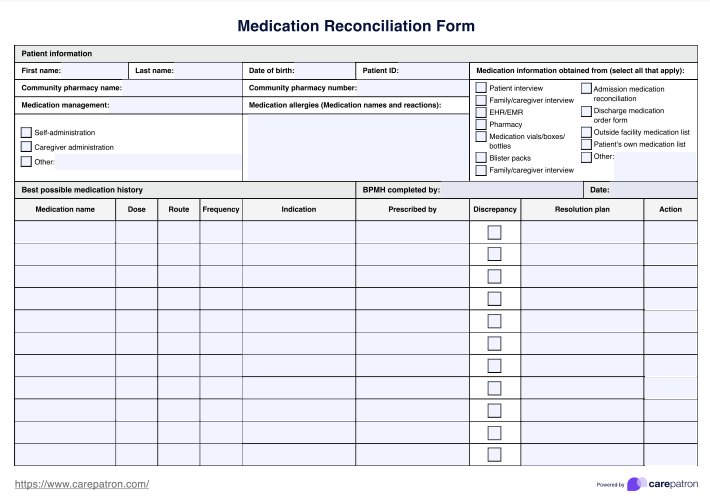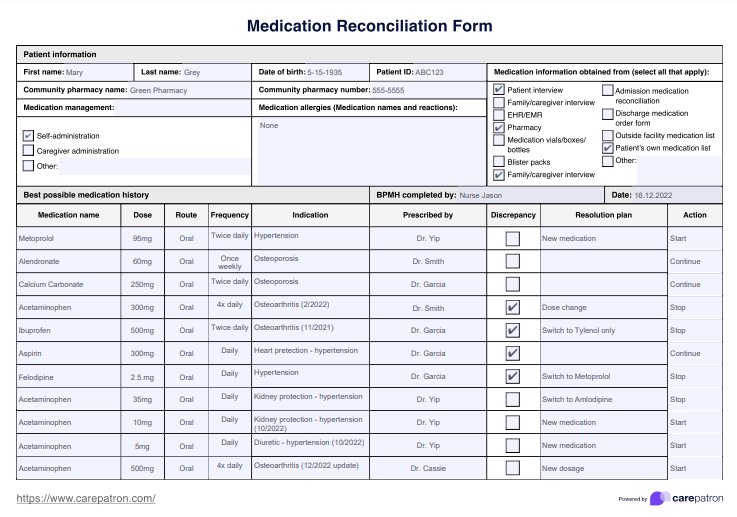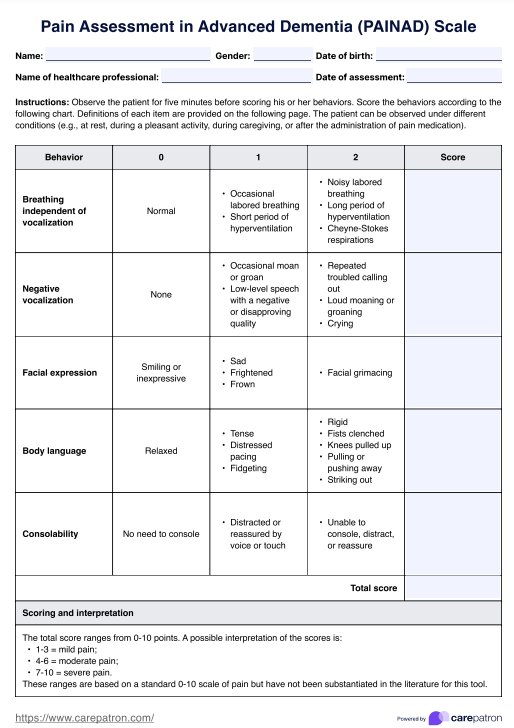Medication Reconciliation Form
Ensure 100% accuracy of your patient’s medication list by using our detailed medication reconciliation form with separate best possible medication history.


What is a Medication Reconciliation Form?
A Medication Reconciliation Form is a resource used by different healthcare providers, from nurses to physicians, pharmacists, and event specialty physicians, to note down and keep track of their patient’s complete list of current medications. This form integrates admission medications, in-hospital changes, and discharge medications in a single form. Not only does this resource avoid problems or address issues like missed, incorrect transcription, or erroneously documented medication that can lead to patient harm, but it also smoothens the medication reconciliation process, especially for patients who have had transitions of care from changing locations to switching providers.
An accurate list of current medications is one of the most integral parts of a patient’s medical history. When there are discrepancies in what over-the-counter and prescribed medications the patient is currently taking or which they should continue with, the risk of making a poor treatment decision greatly increases. Hence, having and using a Medication Reconciliation Form like ours is important.
Medication Reconciliation Form Template
Medication Reconciliation Form Example
How to use our Medication Reconciliation Form template?
Achieving the best possible medication reconciliation for your patient is a careful and involved process. While this form is designed to help you work methodically, it is a good idea to understand how to proceed using this printable Medication Reconciliation Form template.
Step 1: Patient information
The first thing you have to do is fill in your patient's information. This section includes details on their allergies, medication management, and community pharmacy contact details. Conducting a medication reconciliation is a team effort between physicians, nurses, pharmacists, the patient, and their family/caregivers, so having these contact details will be very handy.
Step 2: Best possible medication history (BPMH)
Obtain information on your patient's medication history, whether through your EHR or their primary care physician, family members, previous discharge letters, medication orders, pharmacy records, or even labels on their bottles or boxes. Note down the information and sources in the form. Remember to include both prescription medications and over-the-counter drugs to ensure a comprehensive medication history.
Step 3: Evaluate discrepancies in BPMH and set actions
Once you’ve obtained the BPMH, it’s time to work through all the discrepancies you found in the prescription drugs and over-the-counter medications. Check the discrepancy box for any discrepancies you encounter (wrong medication, wrong dosage, incorrect or incomplete prescription, etc.).
Step 4: Reconciled medication list
With your team, decide on a resolution plan for each medication. Conduct a review of the action your patient is to take. Use "Start" to add a new medication to the regime, "Continue" to keep a medication unchanged, and "Stop" for any medications the patient must cease taking. Note these are all on the second page of the template. It'll be the patient's new medication regime with all discrepancies resolved.
Step 5: Sign, date, and store securely
Ensure that the person completing each table signs and dates this document to authorize the Medication Reconciliation Form and improve accountability within the reconciliation process. If you have worked as part of a team, include the names of the members of your multidisciplinary team here. Lastly, store the reconciliation form securely.
Benefits of using Medication Reconciliation Form templates
There are numerous benefits to using a Medication Reconciliation Form and the template of a med reconciliation form instead of making one from scratch. Here are some of them:
Keep information traceable
By including the names of the medications assessed, the sources used to create the BPMH, and the name and date of the BPMH creation, you can help improve your patients' medical records for the next time they transfer care.
Flowchart format
A medication reconciliation is more than a single table and involves several steps requiring careful attention. To help aid this process, we have created this Medication Reconciliation Form in a flowchart format - where medications are identified as to be started or continued in the BPMH flow onto the reconciled medication list.
Improve coordination of care
This tool will prove invaluable for improving your patient's care coordination. With a single, accurate source for your patient's current medications, all of those involved in your patient's care, including pharmacists, nurses, caregivers, and anyone else who treats your patient, will benefit.
Reduce medication errors
By identifying discrepancies in your patient's BPMH, you can prevent the error from propagating into your reconciled medication list. Within your multidisciplinary team, you can work on a solution to resolve these discrepancies and ensure the reconciled medication list is as error-free as possible, significantly reducing the risk of adverse drug events and improving overall medication safety.
Standardize the reconciliation process
Medication reconciliation processes should be conducted for every patient when transferring care to a new provider, service, or location. As such, you may have to become very familiar with this process, and having a standardized method of conducting these reconciliations will be an invaluable tool for you and your team.
Dedicated action section
When working within a team to solve complex problems, it can be easy for loose ends to go untied. To prevent this, there's a dedicated column in the template for selecting your chosen action. This ensures you have a plan for your patient, and no grey areas remain regarding their medication regime once the reconciliation process is complete.
Commonly asked questions
Medication reconciliation refers to the process of making the most accurate possible list of medications for a patient. This process involves verifying the patient's current medications, clarifying that the medications, doses, and frequency of the medications to be taken are appropriate, and reconciling the final list of medications for the patient.
Some patients may have incomplete or conflicting medication histories due to transcription errors or missing information upon intake or transfer between institutions. Accurate knowledge of a patient's current medications is an integral part of every medical treatment or procedure, so it is worth investing time in reconciling a patient's medications if they have transitioned across services.
There is only so much you can do to obtain past medication information on your patient. If the records have been lost, deleted, or were not taken accurately in the first place, you cannot track them down. As such, we call it the best possible medical history, as you will create the best medication history from the information you have.














































































































